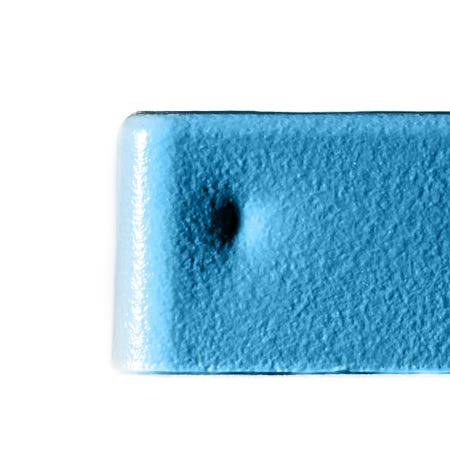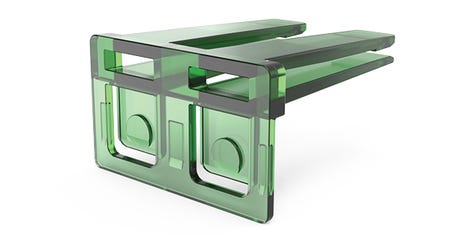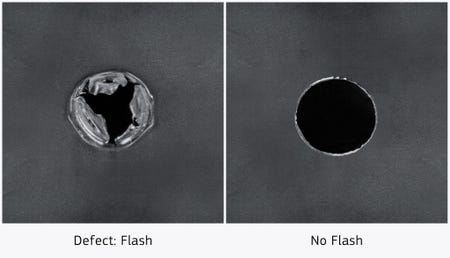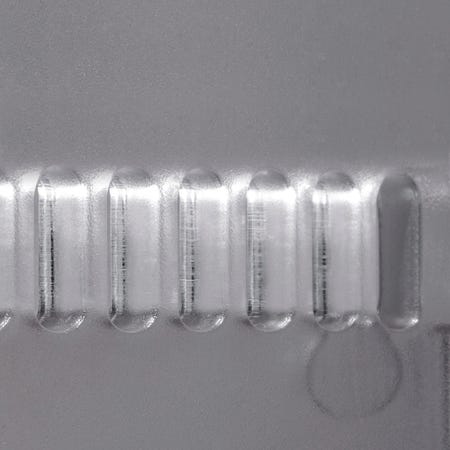August 24, 2023

Lucas Tofteland, injection molding product manager at Protolabs
We’ve made hundreds of thousands of molds over the years! With that much experience, it goes with the territory that we’ve seen designs in which injection molding expertise is evident, and other designs that just won’t produce functional tooling and quality parts. Let’s talk about six avoidable aesthetic issues that designers should be aware of that you might see in molded parts: sink, warp, drag, swirling, knit lines, and flash. The more you understand about these, the better your chances of getting structurally sound and cosmetically appealing parts and products.
That Sinking Feeling

In some ways, molding parts is like baking a soufflé. If the interior doesn’t quickly solidify, the top will slowly collapse on itself, leaving you with a servable, but not nearly as aesthetically pleasing dessert. Same with molded parts.
The sink looks like a dimple on the surface of a molded part. It’s caused by thicker than normal cross sections, non-uniform part design, or an improper gate placement—the doorway through which hot plastic first enters the mold cavity. Polypropylene and acetal are both prone to sinking. If you choose fiber or glass-filled materials, they create a stronger bond and are less likely to sink. From a design perspective, one way to avoid this issue is to follow our wall thickness recommendations for each material, which advise that a workpiece's minimum wall thickness be no less than 40 to 60 percent of its thickest section. Plus, whenever possible, material flow within the mold should travel from thick to thin, so you might have to reorient the mold cavity or place the gate in an area you originally reserved for a cosmetic surface.
While thick features can certainly be problematic, you can go too far in the other direction as well. Thin features are another important thing to keep in mind when designing parts. For example, if you have ribbing built into your part for support, but those ribs are too thin they will cool at a much faster rate than the surrounding material. This expedited cooling will show itself similarly to thick regions, appearing as sink or shadow marks on the exterior of the part. Thin areas are also difficult to eject from, meaning you could see part deformation or even pin punch. Areas with very thin cross sections are also difficult to fill or push plastic through, which could lead to incomplete filling of the part or weak areas where weld lines do not fully bond.
Elude Warp When Using Injection Molding

A moment ago we mentioned that fiber- or glass-filled materials strengthen bonds in the materials to help avoid sink. On the downside, if you choose these, you’re more likely to deal with warp. Here’s why: As the part cools, the glass fibers tend to line up in the same direction, creating internal stresses. Also, when you design a part with walls too thin for the target material, it’s likely to curl up like a potato chip. Yum? No. That’s warp and is easily avoided by following the same rules used with sink, namely staying within the general wall thickness guidelines. Parts with internal support structures—gussets to support thin walls or ribbing of large flat surfaces—fare best against warp.
Embrace the Draft

One of the most satisfying things to watch when injection molding parts is when the ejector pins pop the parts out without snagging. You can ensure that happens by adding sufficient draft. There’s a reason why cake pans expand toward the top: It makes it easier for your dessert to come out in one piece. That’s draft, and it’s an important part of any mold design. Vertical walls—the ones with surfaces parallel to the direction of mold operation—should have a minimum draft angle of a 1/2 degree. Want to be really safe? Two degrees is even better and heavily textured surfaces may require five degrees or more to get that satisfying pop-out of your parts. Without proper draft, part ejection becomes difficult if not impossible, and ugly drag or scrape lines may ruin the aesthetics of your parts.
Flash! Read all About It!

You’ve just made the perfect PB&J. You pick it up, hold the bread in your hands, and take a bite, only to watch the best part of the sandwich plop onto your lap, ruining your day. Flash is kind of like that. Another example: Look closely at a rubber O-ring and you’ll see a thin line surrounding it. That extra material, called a parting line is where the two halves of the mold come together to form your part, squashing out onto the periphery. Free-flowing materials often have this issue, and if it’s a concern, you’ll need to trim each part after it has cooled. On parts like this, you’re going to get some flash, but on orthogonal parts, you can be strategic about where your seams are to avoid obvious flash.
Avoid Swirling in Injection Molding

No one wants their parts to look like a marble cake. To avoid that, add color to your parts. We stock more than 40 standard colorants which are mixed with natural resin pellets before the molding run. The combination is usually quite close to the target color, but the final product may vary due to the polymer being used, texture and polish of the tool, and swirling during the mixing process. If you want an identical color match on your parts, it’s best to purchase color-matched, pre-compounded resin from an external vendor. We accept most customer-supplied resins sent our way.
Nitpicking About Knit Lines

When two streams of molten plastic meet in a mold, it’s doubtful that they will blend together peacefully. Instead, they are more likely to stay separated with a dividing line between them. You often see them at the edge of a hole or other cored feature. For the most part, knit lines are purely cosmetic, but just like two pieces of wood glued along an edge, that spot could fail if it encounters substantial stress, such as from a screw. In this case, designing a strengthening boss feature around the hole is a good precaution, or just skip the hole entirely and drill it afterwards.
You May Also Like



